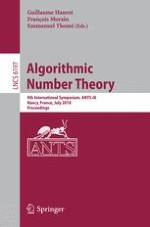2010 | Book
Algorithmic Number Theory
9th International Symposium, ANTS-IX, Nancy, France, July 19-23, 2010. Proceedings
Editors: Guillaume Hanrot, François Morain, Emmanuel Thomé
Publisher: Springer Berlin Heidelberg
Book Series : Lecture Notes in Computer Science
